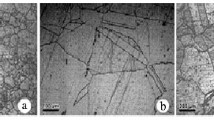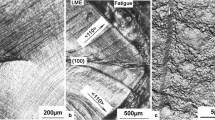Abstract
The influence of various gasenous environments on fatigue crack propagation has been determined for three quenched and tempered steels with yield strength levels of 800 to 1400 MN/m2. The crack growth rate was increased by an order of magnitude in low pressure (13 KPa) hydrogen, and by a factor of two in most mildly aggressive environments relative to the growth rate in vacuum. The gases oxygen, acetylene, carbon monoxide, and nitrous oxide were dominant in a combined environment with hydrogen while methane and carbon dioxide had only a small effect on crack propagation when added to hydrogen. The crack propagation in acetylene was intermediate between that in hydrogen and the mildly aggressive environments. The increase in fatigue crack propagation rate in the hydrogen environment was dependent on the temperature and the cyclic stress intensity. The fracture mode was transgranular for all conditions except the hydrogen influenced HP-9-4-20 fractures. These results are discussed relative to various stages of the hydrogen embrittlement mechanisms. In pacticular, the results are discussed with respect to the adsorption-dissociation of the environment, transport of the gaseous specie within the plasticly deformed zone by mobile dislocations and interaction with segregated impurities within the metal.
Similar content being viewed by others
References
W. H. Johnson:Proc. Roy. Soc., 1875, no. 158.
W. Hoffman and W. Rauls,Welding J., 1965, vol. 44, p. 225-S.
G. G. Hancock and H. H. Johnson:Trans. TMS-AIME, 1966, vol. 236, p. 513.
H. L. Marcus and P. J. Stocker: AGARD Conference Proceedings No. 98, Specialists Meeting on Stress Corrosion Testing Methods, Rev. 16, Brussels, Belgium, 1969.
J. D. Frandsen, N. E. Paton, and H. L. Marcus:Met. Trans. 1974, vol. 5, p. 1655.
J. D. Frandsen, W. L. Morris, and H. L. Marcus: inHydrogen in Metals, p. 633, ASM, Metals Park, Ohio, 1974.
G. F. Pittinato:Trans. ASM, 1969, vol. 62, p. 410.
L. H. Germer and A. U. MacRac:J. Chem. Phys., 1962, vol. 37, p. 1382.
W. A. Spitzig, P. M. Talda, and R. P. Wei:Eng. Fract. Mech., 1968, vol. 1, p. 155.
H. W. Liu, Ya-Lung Hu, and P. J. Ficalora:Eng. Fract. Mech. 1973, vol. 5, p. 281.
S. Mostovoy, R. P. Crosley, and E. J. Ripling:J. Mater., 1967, vol. 2, p. 66.
H. L. Marcus and G. C. Sih:Eng. Fract. Mech, 1971, vol. 3, p. 453.
D. P. Williams and H. G. Nelson:Met. Trans. 1970, vol. 1, p. 63.
R. P. Gangloff and R. P. Wei:Scr. Met., 1974, vol. 8, p. 661.
R. J. Walter and W. T. Chandler: Final Report, NASA Contract NAS8-25579 1973.
R. Broudeur, J. P. Fidelle, and H. Anchére:L'Hydrogène Dans Les Metaux, p. 179, Editions Science et Industrie, Paris, 1972.
A. W. Thompson:Met. Trans. 1973, vol. 4, p. 2819.
M. R. Louthan, Jr., G. R. Caskey, Jr., J. A. Donovan, and D. E. Raul Jr.:Mater. Sci. Eng., 1972, vol. 10, p. 357.
P. Bastien,C. R. Acad. Sci. Paris, 1951, vol. 232, p. 1845.
J. D. Frandsen and H. L. Marcus:Scr. Met., 1975, vol. 9, p. 1089.
D. P. Wilhelm: Air Force Flight Dynamics Laboratory Technical Report 69-111, 1970.
H. L. Marcus and J. M. Harris:Scr. Met., 1975, vol. 9, p. 563.
J. R. Rellick and C. J. McMahon, Jr.:Met. Trans., 1974, vol. 5, p. 2439.
K. Yoshino and C. J. McMahon, Jr.:Met. Trans., 1974, vol. 5, p. 363.
J. D. Frandsen, H. L. Marcus, and A. S. Tetelman: inEffect of Hydrogen on Behavior of Materials, p. 299, AIME, New York, 1976.
F. E. Fujita: inFracture of Solids, p. 657, Interscience Publishers, New York, N.Y., 1963.
O. Buck, J. D. Frandsen, C. L. Ho, and H. L. Marcus: Proceedings of 3rd International Conference on Streegth of Metals and Alloys, vol. 1, p. 462, The Institute of Metals and Iron and Steel Institute, 1973.
O. Buck, J. D. Frandsen, and H. L. Marcus:Eng. Fract. Mech., 1975, vol. 7, p. 167.
H. Ishii and J. Weertman:Met. Trans., 1971, vol. 2, p. 3441.
B. M. W. Trapnell:Proc. roy. Soc., London, 1953, A. 218, p. 566.
A. H. Priest, P. McIntyre, and C. E. Nicholson: Report MG/38/72, B.S.C. Corporate Laboratory, 1972.
D. O. Hayward and B. M. W. Trapnell:Chemisorption, p. 254, Butterworths, London, 1964.
Author information
Authors and Affiliations
Additional information
H. L. MARCUS, formerly with Science center, Rockwell International, Thousand Oaks, CA
Rights and permissions
About this article
Cite this article
Frandsen, J.D., Marcus, H.L. Environmentally assisted fatigue crack propagation in steel. Metall Trans A 8, 265–272 (1977). https://doi.org/10.1007/BF02661639
Received:
Issue Date:
DOI: https://doi.org/10.1007/BF02661639




